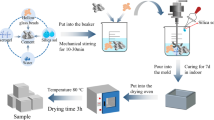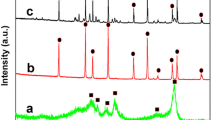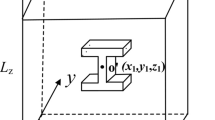Abstract
Understanding the correlation between the physical features of composite components and thermal conductive pathway is beneficial to optimizing the overall heat-transfer performance. Herein, we conduct numerical simulation to investigate the thermal conductivity and heat flux distributions of alumina (Al2O3)-filled composites. The finite element model was verified by both experimental data and theoretical models. The crucial factors include the influence of the interface thermal resistance, the intrinsic thermal conductivity of the matrix and Al2O3 filler, and the size effect of Al2O3 fillers were investigated. For single Al2O3-filled composites, the results indicate that increasing the intrinsic thermal conductivity of the matrix is conductive to bridge the Al2O3 pathway along heat-transfer direction, but there are very limited contributions by enhancing the intrinsic thermal conductivity of Al2O3 filler, tuning the size of Al2O3 filler, and reducing the interface thermal resistance. After introducing the multiscale fillers, it is found that the high thermal conductivity can be achieved by regulating their size matching effect. At the optimal binary ratio of 70:30 (40 µm:15 µm) and ternary ratio of 55:35:10 (40 µm:15 µm:10 µm), the heat-conduction network presents the dominant skeleton of large-sized filler and the bridging branch of small-sized fillers features, which facilitates the formation of a complete and continuous thermal conductive network. This study gives a practical guidance for the thermal conductive design of Al2O3-filled composites.
Similar content being viewed by others
References
Liu Z., Xu J., Xu M., et al., Ultralow-temperature-driven water-based sorption refrigeration enabled by low-cost zeolite-like porous aluminophosphate. Nature Communications, 2022, 13: 193.
Li S., Liu B., Jia X., et al., Dopamine-mediated bacterial cellulose/hexagonal boron nitride composite films with enhanced thermal and mechanical performance. Industrial & Engineering Chemistry Research, 2022, 61(13): 4601–4611.
Guo Y., Yang X., Ruan K., et al., Reduced graphene oxide heterostructured silver nanoparticles significantly enhanced thermal conductivities in hot-pressed electrospun polyimide nanocomposites. ACS Applied Materials & Interfaces, 2019, 11(28): 25465–25473.
Zeng Z., Zeng L., Wang R., et al., Molecular understanding of heat transfer in ionic-liquid-based electric double layers. Journal of Thermal Science, 2023, 32(1): 192–205.
Li T., Wu M., Xu J., et al., Simultaneous atmospheric water production and 24-hour power generation enabled by moisture-induced energy harvesting. Nature Communications, 2022, 13: 6771.
Moore A., Shi L., Emerging challenges, and materials for thermal management of electronics. Materials Today, 2014, 17(4): 163–174.
Li T., Wu M., Wu S., et al., Highly conductive phase change composites enabled by vertically-aligned reticulated graphite nanoplatelets for high-temperature solar photo/electro-thermal energy conversion, harvesting and storage. Nano Energy, 2021, 89: 106388.
Zhao L., Wei C., Ren J., et al., Biomimetic nacreous composite films toward multipurpose application structured by aramid nanofibers and edge-hydroxylated boron nitride nanosheets. Industrial & Engineering Chemistry Research, 2022, 61(25): 8881–8894.
Wu S., Li T., Tong Z., High-performance thermally conductive phase change composites by large-size oriented graphite sheets for scalable thermal energy harvesting. Advanced Materials, 2019, 31(49): 1905099.
Wu S., Li, T., Wu M., Highly thermally conductive and flexible phase change composites enabled by polymer/graphite nanoplatelet-based dual networks for efficient thermal management. Journal of Materials Chemistry A, 2020, 8(38): 20011–20020.
Du R., He, L., Li P., et al., Polydopamine-modified Al2O3/polyurethane composites with largely improved thermal and mechanical properties. Materials, 2020, 13(7): 1772.
Wei Z., Kong X., Cheng J., et al. Constructing a “pearl-necklace-like” architecture for enhancing thermal conductivity of composite films by electrospinning. Composites Communications, 2022, 29: 101036.
Feng C., Chen L., Tian G., et al., Robust polymer-based paper-like thermal interface materials with a through-plane thermal conductivity over 9 Wm−1K−1. Chemical Engineering Journal, 2020, 392: 123784.
Gao B., Xu J., Peng J., et al., Experimental and theoretical studies of effective thermal conductivity of composites made of silicone rubber and Al2O3 particles. Thermochimica Acta, 2015, 614: 1–8.
Yang S., Huang Z., Hu, Q., et al., Proportional optimization model of multiscale spherical BN for enhancing thermal conductivity. ACS Applied Electronic Materials, 2022, 4(9): 4659–4667.
Chen C., Xue Y., Li X., et al., High-performance epoxy/binary spherical alumina composite as underfill material for electronic packaging. Composites Part A, 2019, 118: 67–74.
Feng Q., Liu C., Zhang D., et al., Particle packing theory guided multiscale alumina filled epoxy resin with excellent thermal and dielectric performances. Journal of Materiomics, 2022, 8(5): 1058–1066.
Ngo I., Truong V., An investigation on effective thermal conductivity of hybrid-filler polymer composites under effects of random particle distribution, particle size and thermal contact resistance. International Journal of Heat and Mass Transfer, 2019, 144(2): 118605.
Choi S., Kim J., Thermal conductivity of epoxy composites with a binary-particle system of aluminum oxide and aluminum nitride fillers. Composites Part B, 2013, 51: 140–147.
Yang D., Huang S., Ruan M., et al., Mussel inspired modification for aluminum oxide/silicone elastomer composites with largely improved thermal conductivity and low dielectric constant. Industrial & Engineering Chemistry Research, 2018, 57(9): 3255–3262.
Sanada K., Tada Y., Shindo Y., Thermal conductivity of polymer composites with close-packed structure of nano and micro fillers. Composites Part A, 2009, 40(6–7): 724–730.
Ngo I., Byon C., Lee B., Analytical study on thermal conductivity enhancement of hybrid-filler polymer composites under high thermal contact resistance. International Journal of Heat and Mass Transfer, 2018, 126: 474–484.
Maxwell J.C., A treatise on electricity and magnetism. Nature, 1873, 7: 478–480.
Bruggeman D.A.G., Calculation of various physics constants in heterogenous substances I dielectricity constants and conductivity of mixed bodies from isotropic substances. Annalen der Physik, 1935, 24(7): 636–664.
Nielsen L.E., The thermal and electrical conductivity of two-phase systems. Industrial & Engineering Chemistry Fundamentals, 1974, 13(1): 9–12.
Tong Z., Liu M., Bao H., A numerical investigation on the heat conduction in high filler loading particulate composites. International Journal of Heat and Mass Transfer, 2016, 100: 355–361.
Mao L., Han J., Zhao D., et al., Particle packing theory guided thermal conductive polymer preparation and related properties. ACS Applied Materials & Interfaces, 2018, 10(39): 33556–33563.
Zhu C., Yang W., Xu H., et al., A general effective thermal conductivity model for composites reinforced by non-contact spherical particles. International Journal of Thermal Sciences, 2021, 168: 107088.
Kima D., Lima J., Yu J., Efficient prediction of the electrical conductivity and percolation threshold of nanocomposite containing spherical particles with three-dimensional random representative volume elements by random filler removal. Composites Part B, 2019, 168: 387–397.
Li H., Zheng W., Enhanced thermal conductivity of epoxy/alumina composite through multiscale-disperse packing. Journal of Composite Materials, 2021, 55(1): 17–25.
Rong Y., Fan S., Ling Z., et al., Highly enhanced thermal conductivity of epoxy composites by constructing dense thermal conductive network with combination of alumina and carbon nanotubes. Composites Part A, 2019, 125: 105496.
Chen Y., Hou X., Liao M., et al., Constructing a “pea-pod-like” alumina-graphene binary architecture for enhancing thermal conductivity of epoxy composite. Chemical Engineering Journal, 2020, 381: 122690.
Wu J., Song X., Gong Y., et al., Analysis of the heat conduction mechanism for Al2O3/silicone rubber composite material with FEM based on experiment observations. Composites Science and Technology, 2021, 210: 108809.
Chen L., Sun Y., Xu H., et al., Analytic modeling for the anisotropic thermal conductivity of polymer composites containing aligned hexagonal boron nitride. Composites Science and Technology, 2016, 122: 42–49.
Li S., Liu B., Jia X., et al., Numerical simulation on the optimization of the anisotropic thermal conductivity of hexagonal boron nitride/nanofiber composite films. Industrial & Engineering Chemistry Research, 2023, 62(7): 3183–3193.
Niu B., Cai D., Yang Z., et al. Finite element analysis of effect of grain orientation on the thermal conduction of h-BN ceramics. Ceramics International, 2020, 46: 11631–11637.
Cernuschi F., Ahmaniemi S., Vuoristo P., et al., Modelling of thermal conductivity of porous materials: application to thick thermal barrier coatings. Journal of the European Ceramic Society, 2004, 24(9): 2657–2667.
Tian W., Fu M., Qi L., et al., Interphase model for FE prediction of the effective thermal conductivity of the composites with imperfect interfaces. International Journal of Heat and Mass Transfer, 2019, 145: 118796.
Zeng J., Fu R., Agathopoulos S., et al., Numerical simulation of thermal conductivity of particle filled epoxy composites. Journal of Electronic Packaging, 2009, 131(4): 041006.
Cheng H., Torquato S., Effective conductivity of periodic arrays of spheres with interfacial resistance. Proceedings of the Royal Society a Mathematical Physical & Engineering Sciences, 1997, 453(1956): 145–161.
Putnam S., Cahill D., Ash B., et al., High-precision thermal conductivity measurements as a probe of polymer/nanoparticle interfaces. Journal of Applied Physics, 2003, 94(10): 6785–6788.
Smith D., Fayette S., Grandjean S., et al., Thermal resistance of grain boundaries in alumina ceramics and refractories. Journal of the American Ceramic Society, 2003, 86(1): 105–111.
Gu J., Ruan K., Breaking through bottlenecks for thermally conductive polymer composites: a perspective for intrinsic thermal conductivity, interfacial thermal resistance and theoretics. Nano-Micro Letters, 2021, 13: 110.
Guo Y., Qiu H., Ruan K., et al., Hierarchically multifunctional polyimide composite films with strongly enhanced thermal conductivity. Nano-Micro Letters, 2022, 14: 26.
Guo Y., Ruan K., Gu J., Controllable thermal conductivity in composites by constructing thermal conduction networks. Materials Today Physics, 2021, 20: 100449.
Acknowledgments
This work was supported by the National Natural Science Foundation of China (51606190 and 52006219) and the Strategic Priority Research Program of the Chinese Academy of Sciences (Grant No. XDA 21000000).
Author information
Authors and Affiliations
Corresponding authors
Ethics declarations
HUAI Xiulan is an editorial board member for Journal of Thermal Science and was not involved in the editorial review or the decision to publish this article. All authors declare that there are no competing interests.
Supporting Information
Rights and permissions
About this article
Cite this article
Li, S., Liu, B., Jia, X. et al. Optimization of Thermal Conductivity of Alumina-Filled Composites by Numerical Simulations. J. Therm. Sci. 32, 1569–1582 (2023). https://doi.org/10.1007/s11630-023-1827-6
Received:
Published:
Issue Date:
DOI: https://doi.org/10.1007/s11630-023-1827-6




